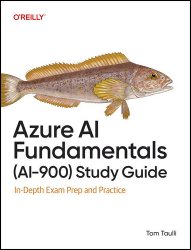Azure AI Fundamentals (AI-900) Study Guide: In-Depth Exam Prep and Practice
- Добавил: literator
- Дата: 8-05-2025, 23:25
- Комментариев: 0
 Название: Azure AI Fundamentals (AI-900) Study Guide: In-Depth Exam Prep and Practice
Название: Azure AI Fundamentals (AI-900) Study Guide: In-Depth Exam Prep and PracticeАвтор: Tom Taulli
Издательство: O’Reilly Media, Inc.
Год: 2025
Страниц: 184
Язык: английский
Формат: True EPUB (Retail Copy)
Размер: 10.1 MB
Businesses that want to stay competitive know that AI has become a crucial technology—and so do their employees looking to grow their careers. Earning Microsoft's AI-900: Azure AI Fundamentals certification proves your proficiency with foundational AI concepts. This study guide equips you with the knowledge needed to pass the AI-900 exam, whether you're an IT professional, a data analyst, or a student looking to break into the AI field.
Packed with clear explanations, real-world examples, exam tips, and practice questions, this comprehensive handbook is your go-to resource for mastering the Azure AI platform and advancing your career. You'll explore key exam topics, including Machine Learning, computer vision, and Generative AI, while gaining practical insights into leveraging Azure's powerful AI tools.
Among the myriad AI certifications available, one stands out: the Azure AI Fundamentals (AI-900) exam. It doesn’t just skim the surface. It dives into key AI domains like Machine Learning (ML), Deep Learning (DL), natural language processing (NLP), computer vision, Generative AI, and Responsible AI. Of course, there is coverage of key solutions from Microsoft Azure.
So whether you’re charting a new career path or bolstering your current role, the AI-900 certification equips you with a solid foundation. And this book is your ally in that journey. Packed with the resources you need to pass the exam, it’s also a handy reference guide for broader AI topics.
Here’s a brief look at each chapter:
Chapter 1, “Introduction to the AI-900 Exam,” provides an overview of the Microsoft Azure AI-900 certification. The chapter highlights the career advantages of earning this certification. It also details the exam structure as well as key topics like AI workloads and ML principles, and it offers guidance on preparation resources and complementary certifications.
Chapter 2, “Azure AI Services,” describes the basics of the Azure platform as well as how to set it up. The chapter also explores creating an Azure resource, which is required to perform various types of AI tasks, and we take a look at Azure AI Foundry, which allows you to create AI applications.
Chapter 3, “Overview of AI Workloads and Key Use Cases,” explores various AI workloads and their practical applications. It introduces foundational technologies like content moderation, personalization, computer vision, NLP, knowledge mining, document intelligence, and generative AI. The chapter also stresses responsible AI principles, including fairness, reliability, transparency, and inclusiveness.
Chapter 4, “Fundamental Principles of Machine Learning,” looks at key ML concepts and techniques. It describes supervised learning methods like regression and classification, unsupervised techniques such as clustering, and the distinction between ML and DL. The chapter then looks into the ML workflow, from data preparation and training to inferencing.
Chapter 5, “Azure Machine Learning,” explores how Azure’s cloud-based service simplifies the training, deployment, and management of ML models. It highlights two key tools: Azure Automated Machine Learning (AutoML) for automating model development and Azure Machine Learning Designer, a no-code, drag-and-drop interface for creating pipelines.
Chapter 6, “Features of Computer Vision Workloads on Azure,” looks at the fundamentals of computer vision. It covers Azure’s suite of computer vision tools, including Azure AI Vision for general image analysis, Azure AI Custom Vision for tailored image recognition, and Optical Character Recognition (OCR) for extracting text from images. Key techniques like image classification, object detection, and facial analysis are detailed with practical examples. The chapter also explains the role of convolutional neural networks (CNNs) in analyzing image patterns and discusses multimodal models.
Chapter 7, “Features of Natural Language Processing Workloads on Azure,” explores key NLP concepts and their applications. It introduces Azure services for NLP, including Azure AI Language for tasks like sentiment analysis, entity recognition, and key-phrase extraction; Azure AI Translator for real-time text translation; and Azure AI Speech for speech-to-text and text-to-speech capabilities. The chapter also looks into foundational NLP techniques such as tokenization, text classification, and semantic language models.
Chapter 8, “Features of Generative AI Workloads on Azure,” highlights the transformative potential of generative AI. It focuses on Azure tools like OpenAI models, DALL-E for image generation, and GPT-4 for advanced language tasks. Key concepts include large language models (LLMs), transformer architecture, tokenization, embeddings, and attention mechanisms.
Chapter 9, “Strategies and Techniques for Successfully Taking the AI-900 Exam,” provides practical guidance for exam preparation and test taking. It emphasizes the importance of leveraging the Microsoft exam sandbox for familiarity and of mastering key topics like AI fundamentals, ML, NLP, computer vision, and generative AI.
Скачать Azure AI Fundamentals (AI-900) Study Guide: In-Depth Exam Prep and Practice
[related-news] [/related-news]
Внимание
Уважаемый посетитель, Вы зашли на сайт как незарегистрированный пользователь.
Мы рекомендуем Вам зарегистрироваться либо войти на сайт под своим именем.
Уважаемый посетитель, Вы зашли на сайт как незарегистрированный пользователь.
Мы рекомендуем Вам зарегистрироваться либо войти на сайт под своим именем.
